As we scampered down the hills of Segesta to head back to the bus, I couldn’t help but feel like I was an extra in the Sound of Music. The stunning landscape of Segesta presented nearly every shade of green to my hungry eyes as I tried to take it all in. As we frolicked the fields, I was reminded of descriptions of the nature of Sicily in Book V of the Aeneid. The scenery of these games is mentioned as being amidst a “gramineum campum” (line 286; a grassy field). This grass is noted as being “viridis” (line 330; fresh/green) in contrast to the red blood which sabotages Nisus’ victory. This brilliance of color in Sicily is also mirrored in Cavalleria Rusticana, the first film that we watched with the Italian class. Cavalleria Rusticana features several scenes that take place in green, grassy sprawls of land, just like the ones here in Segesta. The Aeneid also notes that the two Sicilians competing in the footrace, Helymus and Panopes, are uniquely “adsueti silvis” (line 301; accustomed to forests). The rustic nature of Sicilians is also reflected in the film, as the characters sing as they frolick across the hillsides, tending to their animals and completing their farm work. As a Classics major who can usually be found cramped up in the Stacks, translating hundreds of lines of Latin and trying to imagine the scenes which ancient authors describe, it was truly extraordinary to be able to actually experience the breathtaking Sicilian countryside which Vergil had promised.
Sicily: The Bread Basket of the Roman Republic
After the sack of Syracuse in 212 BC, the Romans reigned in Sicily for the next six centuries. Due to the island’s advantageous climate and fertile soil, Sicily offered a prosperous source of grain. Sicily was agriculturally exploited in order to supply the Roman Republic with wheat, an act which likely hindered the economic development of the island. Nevertheless, due to the island’s status as a “breadbasket” for Rome and the fruitful abundance of the island, the cult of Demeter became prominent throughout Sicily. In his Metamorphoses, Ovid even places the myth of Persephone’s abduction by Hades and Demeter’s ensuing search for her daughter in Sicily. As we walked up and down the streets of Palermo, I couldn’t help but notice the ubiquitous statues and plaques celebrating the goddess Demeter. Below are but three of many representations of Demeter and grain that can be found throughout the city of Palermo.



La Zisa
Jet-lagged, hungry, and admittedly a bit cranky, our first day in Sicily was doubtlessly a daze for all. The architectural wonder that is La Zisa certainly did not subtract from our conviction that this trip was but a dream and Sicily a fantasy land.
Derived from the Arabic term “al-aziza” meaning “the gorgeous,” La Zisa was built in the twelfth century and designed to serve as a summer retreat for the Norman Kings ruling Sicily at that time. The partnership between the Norman King William I, who financed the construction, and the Arab architects responsible for the Islamic architecture demonstrates how eagerly the Normans appropriated the style of the pre-existing Arabic culture. An example of such Moorish decoration can be seen in the main hall. Throughout the palace but notable here in the main hall are cavities in the wall filled with Arabic stalactite work, a typical Islamic ornamental design known as mocárabe.
 Interestingly, on the ceiling of the main hall was a painting featuring several Classical gods, demonstrating the eclectic design of the palace due to the many rulers throughout Sicily’s history. Some of the gods and goddesses painted on the fresco can be recognized by their famous attributes: Poseidon brandishing his trident, Phoebus with his lyre, Mercury with his caduceus, winged sandals, and winged cap, Minerva dressed in her warrior garb, Hercules with his club and lion skin, the nude Venus with her naked son Cupid, and the blacksmith Vulcan with his hammer.
Interestingly, on the ceiling of the main hall was a painting featuring several Classical gods, demonstrating the eclectic design of the palace due to the many rulers throughout Sicily’s history. Some of the gods and goddesses painted on the fresco can be recognized by their famous attributes: Poseidon brandishing his trident, Phoebus with his lyre, Mercury with his caduceus, winged sandals, and winged cap, Minerva dressed in her warrior garb, Hercules with his club and lion skin, the nude Venus with her naked son Cupid, and the blacksmith Vulcan with his hammer.